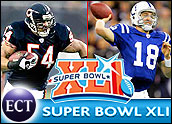
Super Bowl XLII may have been an historic upset, but the Internet traffic driven by the multimillion-dollar advertising largely held true to form.
Web hosting and domain registration company GoDaddy.com appeared to have once again stirred up the most excitement, using a tried-and-true formula — a tantalizing, suggestive ad — and a new twist to drive millions of users to its Web site.
In an ad that ran at the start of the second quarter of the game, the site teased Super Bowl viewers to visit its Web site, where it offered a variety of video ads, including one that it wanted to air during the game but wasn’t allowed to by Fox.
Fox would only agree to run the Patrick ad — which spoofs the revealing attire of celebrities and features an animatronic beaver — if GoDaddy removed the word “beaver” from the text of the commercial, GoDaddy said. Rather than comply, Parsons said he decided to use the Web to show the ad in full.
Traffic Surge
Web infrastructure company Akamai, which tracks traffic patterns through its Net Usage Index, recorded a massive surge in Internet traffic around the time the ad showed, Akamai spokesperson Jeff Young told the E-Commerce Times.
While he did not mention GoDaddy by name and said he could not disclose specific customer information, Young said the Super Bowl featured “one compelling ad event that drove people to the Web in real time.”
For about 15 minutes around the time the teaser version of the full ad — which GoDaddy calls “Exposure” and which the company claims the Fox network rejected as too racy — was shown, traffic surged as high as more than 1.2 million visitors per minute, he said, marking “one of the highest peaks we’ve seen during any of the Super Bowls over the last few years.”
Monday Morning Playback
GoDaddy’s ad, which featured race car driver Danica Patrick, fit the company’s past pattern of running racy ads and of focusing the vast majority of its television ad budget on the Super Bowl.
In a post to his blog, GoDaddy CEO Bob Parsons writes that he is “confident that the commercials will not disappoint those die hard Go Daddy aficionados who count on me to bring a smile and at least a little sunshine into their lives every Super Bowl.”
Others were less charitable. Rival domain registrar Register.com referred to GoDaddy’s ad as its “yearly cry for attention” in a statement e-mailed to the E-Commerce Times.
Rather than discussing its services and features, GoDaddy “elected to focus on scantily clad women and shock value for the purpose of creating some buzz,” said Register.com CEO Larry Kutscher. “We believe businesses are looking for answers, not just flash and sex.”
Muted Impact?
This year, GoDaddy may have stood out even more in part because the company was one of the only pure dot-com companies to be advertising during the game. The ad was also one of the few that intentionally attempted to drive traffic to the Web.
In fact, Young noted, many of the traditional companies that advertised did not even include their Web address during their ads. Akamai provides Web infrastructure support to about half of the companies that advertised during the game, he added.
“There were fewer cliff-hanger endings where the ad tries to send people online to find out the ending,” Young said.
In fact, beyond the time immediately after the GoDaddy ad, Web traffic remained fairly flat, something Young attributed to the close score in the game.
Still, that doesn’t mean the impact of the Web on the Super Bowl ads and their impact will be muted. Akamai was already seeing surges in traffic and demand for online video playbacks of the ads from the major Web news sites for which it handles traffic.
“Advertisers realize that building ads for the Super Bowl now means building them to be replayed online afterwards,” Young said. In fact, many consumers now know the ads will be available online later. A MySpace page where the ads could be ranked and shared was expected to draw heavy traffic after being promoted during the game, he noted.
Driving and Crying
Even without direct calls to action to drive users to the Web, the Internet has become an integral part of many consumers’ Super Bowl, said comScore Senior Analyst Andrew Lipsman.
A comScore survey conducted before game found that more than 75 percent of U.S. Web users planned to be online at some point on Super Bowl Sunday, Lipsman told the E-Commerce Times. Not all that traffic would be aimed at the game or the ads, however, with 16 percent of Web users saying they planned to visit the Web sites of in-game advertisers.
Many did say they planned to go online to re-watch ads that caught their fancy during the broadcast, however, Lipsman said.
“Users are showing a greater inclination to access advertising content online,” he added. “Advertisers who have a cross-media element to their strategy can definitely benefit from that trend.”














































Social Media
See all Social Media